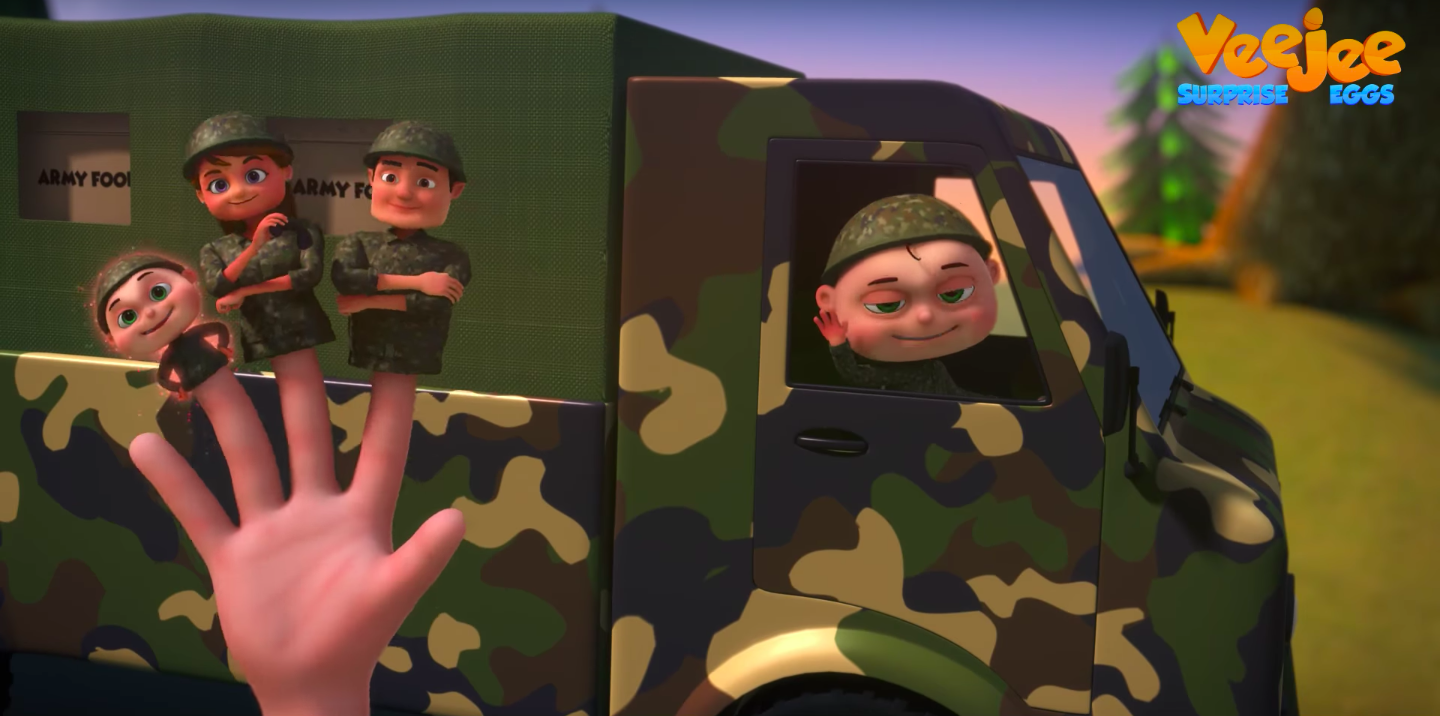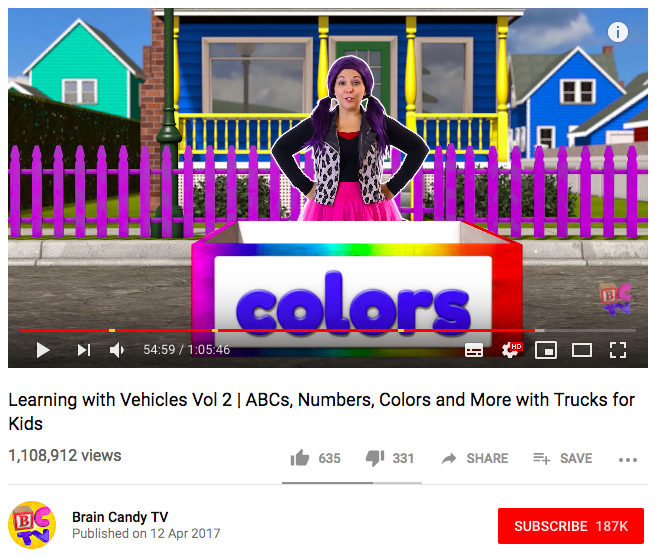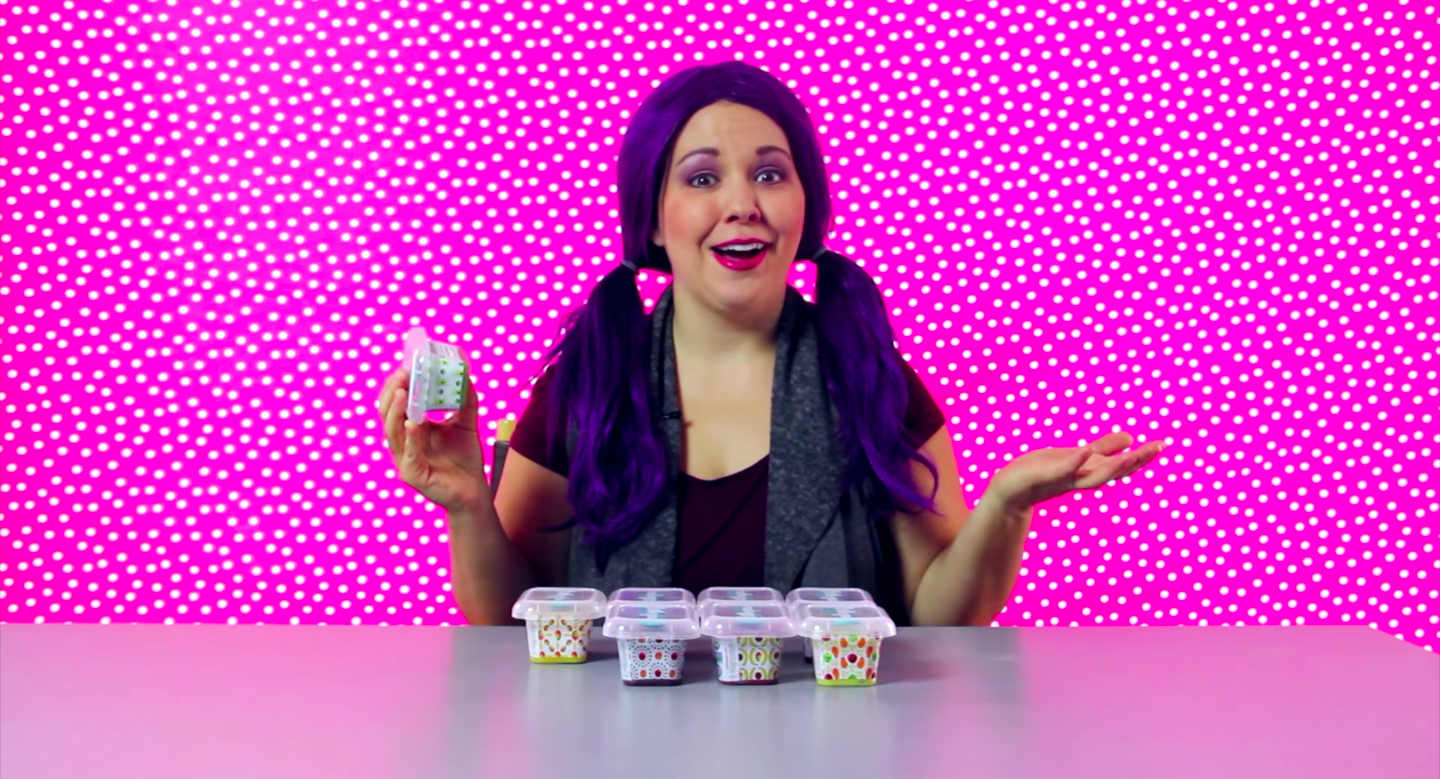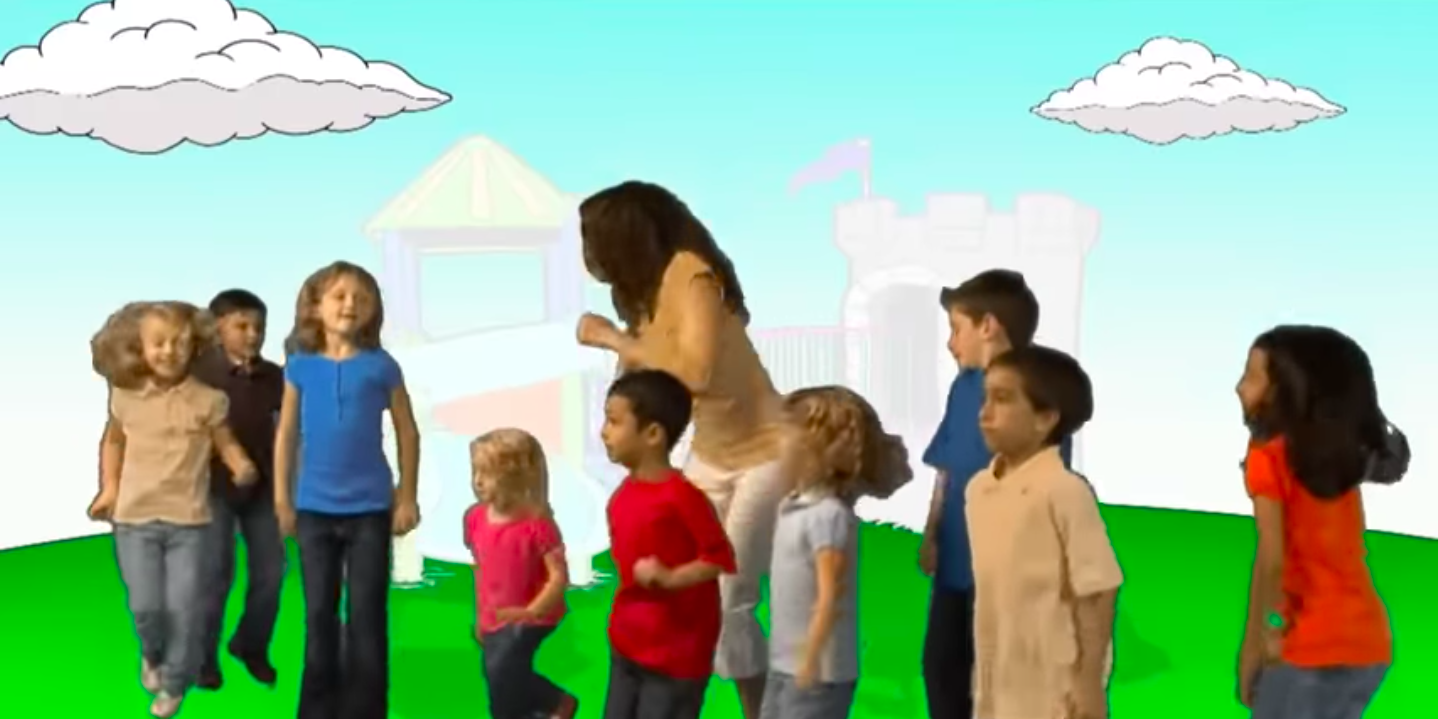YouTubers Are Fighting Algorithms to Make Good Content for Kids
Last month, news feeds were saturated with distressing headlines about Momo. On a basic level, Momo is a pale, monstrous face who told kids to commit acts of self-harm in the middle of a few YouTube videos that targeted children, like videos featuring the animated television character Peppa Pig.
Momo could be understood as a "fake news" story (spread primarily by local TV news stations) that happened to involve YouTube videos aimed at kids. But in a larger sense, as pointed out by the New York Times, Momo is a moral panic about what children see on the internet. Kids being raised today have generationally unprecedented access to social media platforms like YouTube, and parents are afraid about how this level of access, and content served by algorithms, is affecting developing minds.
Parents have always feared how new media affects their kids. Think comic books, Dungeons and Dragons, or video games. But to a certain degree, there are valid concerns about YouTube and what children are watching.
In November 2017, YouTube did a massive purge. One of the major targets of the purge, now known as "Elsagate," was videos that lured kids in using child-like images and tropes (like Elsa from Frozen), but pivoting mid-video into violent, sexual, or otherwise disturbing content. The perpetrators were often channels that bulk-produce animated videos, which are common and popular on kids YouTube.
Channels that mass-create animated videos usually don't show Peppa Pig engaging in cannibalism, or cartoon characters violently killing their families. But they do crank out generic, often mindless videos on a massive scale, which reach young eyes hundreds of billions of times. (Think "Johny Johny, Yes Papa.")
But not all of kids YouTube is a hellscape. In fact, the ecosystem is also home to an entirely different kind of channel: human beings trying to become characters like Mister Rogers, the Wiggles, or a PBS kids show for a new generation. By and large, these YouTubers are striving to make genuinely good, enriching, educational content for children.
These channels are fighting to game YouTube's algorithm to reach young audiences. According to interviews with several of theseYouTube channels, however, they're at a structural disadvantage to compete with channels that make massive amounts of animated videos.
"It's difficult for channels like mine to compete with them too, because they can do like two three videos a day, or at least a few a week," Mike Moore, who runs Brain Candy TV-an animated learning channel with 186,000 subscribers-told Motherboard in a phone call. "It takes me a month or two to make a video. You don't get as much watch time from that."
In a phone call with Motherboard, a YouTube spokesperson said that upload frequency doesn't influence its recommendation algorithm-however, content freshness does. In other words, you won't get an advantage just because you upload once per day. But if your content is consistently new and "fresh," it's more likely to get promoted more frequently.
To many parents, YouTube is also the cheapest and sometimes only option to keep kids entertained. Millennials, some of whom are becoming new parents, by and large don't have cable. According to the Pew Research Center, only 31 percent of people aged 18 to 29 have a cable or satellite subscription, and that number only rises to 52 percent for people aged 30 to 49.
For parents that need to keep their kids entertained, it seems obvious to lean on YouTube-a free service that doesn't require cable. YouTube is also accessible on mobile devices, meaning that parents can use it when they travel with their kids.
But YouTube wasn't constructed to prioritize the development and well-being of young children. It's an ad-driven business, and it relies on a mystery recommendation algorithm designed to keep people on the site, and viewing ads, for as long as possible. The people competing on the platform to reach children are just pawns within YouTube's business interests.
How Does Kids YouTube Work?Mass-created animation channels have become dominant on kids YouTube. For instance, animated nursery rhyme channel ChuChu TV has only been around since 2013, and the channel has 295 videos with 16,781,585,919 views. This level of consumption is fueled by about 200 animators. Meanwhile, for example, the channel Patty Shukla Kids TV has been around since 2006, and it has 270 videos with 505,178,524 views. Patty Shukla Kids TV is run by two people, Neil and Patty Shukla.
The mass-animation channel model is to combine nursery rhymes with familiar stock 2D and 3D animations, and jam pack the video titles with keywords. As detailed in James Bridle's piece on Medium, the result is something that often feels mindless and meaningless. Often, these channels make large numbers of 20+ minute "compilation" videos designed to keep kids in nursery rhyme land for as long as possible.
These channels also prioritize cashing in on child "memes," or viral nursery rhymes, like Finger Family or Baby Shark. Videogyan 3D Rhymes's original family finger video uploaded in 2015 has more than 976 million views. Channels like ChuChu TV and Cocomelon Nursery Rhymes have made versions with 893 million and 150 million views, respectively. A Google video search for "Finger family" and "family finger" elicited a total of 10.6 million results.
 Image: "Soldier Finger Family" video screenshot from YouTube.
Image: "Soldier Finger Family" video screenshot from YouTube. This is not to imply that kids YouTube channels featuring human beings are good because they feature human beings. A major target in the Elsagate purge was live-action channels, that were banned for placing children in vulnerable, abusive, and dangerous situations-like a fake-kidnapping or "mock-torture." Some kids YouTube stars are abused behind the scenes. Recently, YouTube disabled the comment sections for many videos featuring children due to large amounts of comments from pedophiles.
Rather, some live-action channels appear to offer an alternative to trope-driven animation channels and, say, live-action toy review channels showing real children. Characters like Blippi, Tayla Bananas, and Debbie Doo seem to make an honest attempt to keep the humanity in Kids YouTube. Their mannerisms are often similar to characters like Steve from Blue's Clues, or Loonette the clown.
Brain Candy TV, meanwhile, uses a combination of 3D animations, a human voiceover from Moore, and a live-action performance from Moore's dog Lizzy. It's comparable to the approach of shows with animal characters like Zoboomafoo, or Wonder Pets.
Moore also frequently shows monster trucks, which he claims were exciting to him as a child. The "Mega Truck Alphabet" video series shows monster trucks driving through scenarios designed to teach kids the alphabet. In one of the videos, Moore teaches kids about the letter "C" by showing a monster truck driving into a cake in a canyon, Charlie the chipmunk driving through a pile of cubes-you get the idea.
There's also Patty Shukla Kids TV, which features Patty Shukla singing educational songs (not as a particular character, but as herself). Her lyrics are designed to teach lessons in primary school areas, such as phonics, patterns, colors, and the numbers from 1 to 100.
"We both did music full time before the children's music," Patty said. "Once we had children, we started to realize how much more they could learn through music, and it just kind of came organically where we started music to teach them at an early age."
These channels take anywhere from a week to a few months to put out a new video. In comparison, certain animated channels post videos one to three times a day.
Unlike adults, kids often can't search for content, or intelligently navigate channel pages. Instead, they rely on YouTube's recommendation algorithm to find almost all content. On both regular YouTube and Kids YouTube (the YouTube app designed for use by kids), recommended videos show up on the homepage, as well in a column or row next to every video. After you finish any video on regular YouTube or Kids YouTube, a recommended video will play.
Moore from Brain Candy TV told Motherboard that 86 percent of views came from YouTube recommendations, according to his most recent monthly traffic analytics. Also, Tea Time With Tayla-a live-action education show with 135,000 subscribers starring "Tayla Bananas"-generates 55 percent of all its views through YouTube recommendations, according to show producer Dallas Morgan.
But YouTube's recommendation is a mystery, meaning that YouTubers have to use other methods to reach viewers.
Networks of CollaborationA common strategy of kids YouTube channels is to have columns on their channel titled "Friends of," or "Featured." These columns show a list of other channels that creators can pick by hand and recommend to viewers. (This is different than the list of suggested channels that YouTube conjures up automatically based off of user behavior, which is shown below the Friends or Featured column.)
Morgan from Tea Time With Tayla said that the potential benefits of cross-promotion are fairly intuitive.
"They have viewers we don't have, and we have viewers they don't have," Morgan said to Motherboard. "By us cross-promoting, we're sending viewers to them and they're sending viewers to us."
"It seems kids and parents hardly ever visit the channel page and are usually just browsing the videos, or in the case of the kids, just jumping from one recommended video to the other."
Becca Lewis, a political subculture researcher for Data and Society, said that this strategy is common across YouTube. "If you're a smaller influencer trying to make a name for yourself, it can help align yourself with other specific types of content," Lewis said.
For kids YouTube creators, this strategy takes on special importance. Unlike, say, PBS Kids, YouTube doesn't have gatekeepers that decide who can post kids content. This means that, in part, the goal of promoting other channels is to validate one another. Perhaps, if a parent or child trusts one creator, they can trust a whole group of other creators.
This networking also sometimes manifests as in-person collaborations. For instance, "Tayla Bananas" from Tea Time with Tayla is featured in two Brain Candy TV videos-one from two years ago, and one from last year. Tea Time with Tayla recently collaborated with Debbie Doo TV. In 2015, Blippi, Bounce Patrol, and Debbie Doo TV all appeared in the same video.
 Image: Screenshot from Brain Candy TV.
Image: Screenshot from Brain Candy TV. Morgan from Tea Time With Tayla said that for them, collaborations have definitely been an effective tool for their channel. But in an email to Motherboard, Moore from Brain Candy TV said that the strategy doesn't always work.
"I had been on the featured channel list of some of the biggest kids YouTube channels out there for years (Little Baby Bum, Blippi, and more) but I never saw any traffic from there," Moore said. "It seems kids and parents hardly ever visit the channel page and are usually just browsing the videos, or in the case of the kids, just jumping from one recommended video to the other."
There are also reasons to avoid collaborations. Patty Shukla Kids TV, for instance, doesn't hand-pick any "Friends" of the channel to promote on their homepage.
"If one of those other channels does decide to go a different route, we really want to make sure that parents always always trust our content 100 percent," Patty told Motherboard.
People vs. the Recommendation AlgorithmIn conversations with Motherboard, kids content creators consistently expressed frustration on the lack of transparency into YouTube's recommendation algorithm and how it affects viewership, and therefore, how much money the videos make.
"The monetization is all over the place," Neil Shukla from Patty Shukla Kids TV told Motherboard. "It all depends on what category you're in, and all kinds of weird things that go into their sides of the algorithm."
"To be honest, I feel like YouTube's algorithm of recommendations is so complicated, and so intelligent, and it's changing so often that I can't keep up with how they design a lot of that stuff," Morgan from Tea Time With Tayla told Motherboard.
In a phone call with Motherboard, Moore said that he started making YouTube videos full time about five years ago. Previously, he had been working as a wedding photographer.
"I discovered people making a living doing online videos for kids-it was this big epiphany moment for me," Moore said. "I was so excited to discover that this was an option, because it was perfectly in line with what I wanted to do."
But animation takes time, and building an audience takes even more time. "It took a few years to get viewership going," Moore said. "Which is scary when you're working 16 hours a day with no pay for two years. For me, once I realized this was an option, I had no choice but to continue on and push through."

Image: Screenshot from Tea Time With Tayla.
Moore from Brain Candy TV told Motherboard that since he can't make out multiple videos a day, the best way to build an audience is to get kids to watch his videos all the way through. That just comes down to making a good video.
"It just comes down to getting into the minds of kids," Moore said. "I'm just thinking, 'what would I have liked when I was a child? So my voiceover is always excited" I try to make it fun to learn, and of course, having the action-packed vehicles. I think it really makes them wanna keep watching and learning."
Morgan from Tea Time With Tayla explained to Motherboard that it's challenging to create kids characters for YouTube specifically. "Vlogger" personas have thrived on YouTube in part because monetization can be unreliable, meaning production costs have to be low. Filming yourself as your life unfolds is an easy way of minimizing those production costs.
But this "vlogger" persona is often contrary to what makes a character magical for kids. Kids shows typically create characters that exist within an untouchable universe that's real for kids. Meanwhile, vloggers rely on bringing themselves down-to-earth, barely detached from the real universe of viewers.
"We've never really posted any behind the scene photos of Tayla putting her wig on or anything like that," Morgan said. "We really try to make the Tayla Bananas character a real thing that exists, and she lives in this world that is the show."
"As a parent-this is gonna sound funny-but I don't even let my kids watch videos on YouTube."
Morgan said that his wife, Tahlia, came up with the character of "Tayla." Tea Time With Tayla, and its educational mission, all grew from Tayla.
"So much of it really was about this character, the Tayla character: the pink tutu, the purple hair, the funky energy," Morgan said. "I think that's really where it started: people connect with a face, people connect with a character."
 Image: Screenshot from Patty Shukla Kids TV.
Image: Screenshot from Patty Shukla Kids TV. Neil Shukla from Patty Shukla Kids TV told Motherboard that over the past few years, he's noticed that bulk-posting animated channels have become more and more dominant on YouTube. "They've figured out the algorithms way better than we have in terms of how to play the YouTube game," Neil told Motherboard.
Neil told Motherboard that as these animated channels started to rise, he and Patty considered doing more nursery rhyme videos. "We thought about that when we noticed that that was starting to become a thing a few years back," Neil said. "We were like 'man, we really need to do this or we're gonna be left behind.'"
Patty told Motherboard that they once did an album of nursery rhymes. "We quickly realized [that] while those are super and nice for people to have, it really is not our focus," Patty said. "That's why our channel is different, because it is original music and educational music."
"But it's hard," Patty said. "You think that that's what people want. But you put it out, and then you realize quickly, no-we're gonna stick with learning, with what we do."
Moving Outside of YouTubeAccording to kid content creators on YouTube, the "Elsagate" purge in late 2017 had unintended consequences. Patty Shukla told Motherboard that YouTube flagged and removed more than fifty of their videos. This is because videos were being flagged automatically and on the basis of the comments, not the actual content of the videos.
"They have reinstated all of the videos and made them findable again," Patty said. "But it really just opened our eyes to wow, that was pretty devastating."
Patty said that this event specifically drove the family to diversify Patty Shukla Kids TV onto other platforms, such as Amazon Prime.
Morgan from Tea Time With Tayla said that they've also brought their channel to streaming platforms like Amazon Prime, Pluto TV, and Kidoodle TV.
"Our focus over the past few years has been to make Tea Time with Tayla not so much a YouTube show, but really just a general kids show that's available on a variety of platforms, and YouTube happens to be one of those," Morgan said.
Morgan said that for several years, when almost all of Tea Time WIth Tayla's viewership came from YouTube, most of their revenue was ad-based revenue. But over the past two years, ad revenue decreased significantly.
"We were really exploring, do we need sponsors to supplement the revenue here so that we can continue producing shows?" Morgan said. "But we didnt love doing that."
Morgan told Motherboard that there's an advantage to platforms with alternative business models-like subscription-based platforms, or platforms where users pay for individual videos-there's less pressure to do in-video sponsorships for products. According to Morgan, doing product promotion seemed contrary to Tea Time With Tayla's educational mission.
Morgan said he'd encourage parents to use platforms besides YouTube because it's more highly curated, and safer for kids.
"For me, I have three kids. As a parent-this is gonna sound funny-but I don't even let my kids watch videos on YouTube," Morgan said. "We'll let them watch kids shows on other services. We let them watch stuff on Amazon or Netflix or anything like that. But for us, we've just found on YouTube, there's so much content. Kids are just too smart. Unless you're watching them like a hawk, you don't know where they're gonna end up."
Becca Lewis told Motherboard that YouTube was originally hailed as a democratizing force for media where anyone could share content with the world. But kids YouTube is basically a case study showing that gatekeepers can serve important functions.
"[Gatekeepers] can be really stifling or exclusionary in some ways, but they also serve this purpose of signaling that certain content can be trusted," Lewis said. Now there is a question mark of who do you trust in this media environment when anyone can create content. It's the double edged sword of this democratized broadcast system."